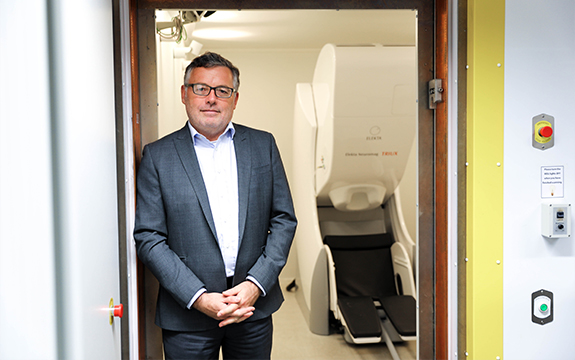Swinburne establishes new neuroimaging facility

In Summary
- This article originally featured in Swinburne's Research Impact magazine.
Swinburne’s new neuroimaging facility is being set up to take part in the next big wave in data-driven insight.
Professor Tom Johnstone — the former Director of Neuroimaging at the University of Reading in the United Kingdom — moved to Australia to become Director of the new $40 million facility in July 2018.
He said the advance of neuroscience data must be carefully managed. “Neuroscience has moved far beyond simply looking at blobs of brain activation, to looking at complex networks and interactions between neural, behavioural and physiological measures.”
This produces a lot of data; a single neuroimaging dataset can measure in the terabytes, two to three orders of magnitude larger than a complete mammalian genome.
To manage Swinburne’s new data collection, Johnstone has introduced the Brain Imaging Data Structure (BIDS), a global open software system put together in 2016 by a number of the world’s most well-known universities. With it, neuroscientists have standardised data formats and parameters to minimise errors caused by using different processes or the rearranging of data.
“BIDS enables quality-controlled data processing pipelines that allow people from multiple centres to share and verify data,” Johnstone explained. The new system will allow Swinburne to contribute to, and use information from, other institutes.
BIDS also makes computer analysis of studies vastly easier, and Swinburne’s Data Science Research Institute will be collaborating with the facility to help analyse information using machine-learning programs.
Located in the Advanced Technologies Centre, the facility has been equipped with every contemporary type of technology for measuring brain activity, including a state-of-the-art magnetic resonance imaging (MRI) scanner for visualising brain structure and function, plus six electroencephalography labs, and a magnetoencephalography lab for measuring the brain’s electrical activity.
Swinburne’s new facility is funded by the university, the National Imaging Facility, and the Victorian Bioimaging Capability. It will build on a decade of work by Swinburne’s Brain and Psychological Sciences Research Centre.
As this new capability comes online, Johnstone is working to broaden the facility’s user base. “Addiction, pharmaceuticals, and the effects of diet on brain function are already a very strong focus of neuroimaging research, and Swinburne’s Centre for Mental Health also focuses on clinical psychology and psychopathology.”
Among the list of new projects is work on brain stimulation devices (see right), and autism.

